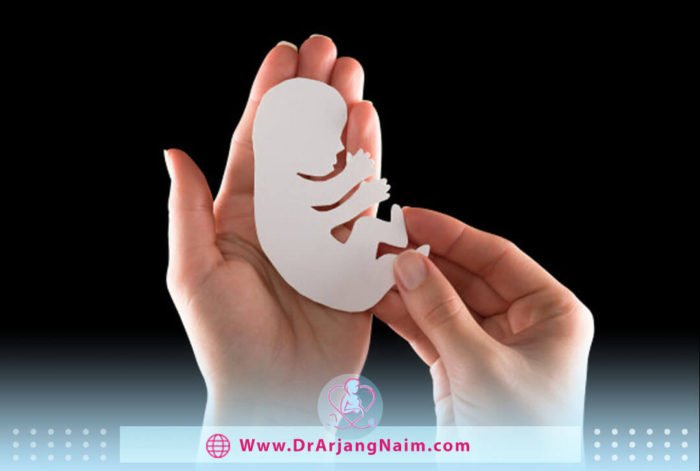Recurrent Pregnancy Loss is a painful experience for the doctor and the patient and one of the most common pregnancy complications, with a prevalence of 3%.
Fetal death before development and reaching the end of pregnancy, from birth to before the twentieth week of pregnancy, is called a miscarriage. If a Pregnancy Loss occurs more than three in a row in subsequent pregnancies, it is called Recurrent Pregnancy Loss or recurrent miscarriage that needs further investigation and follow-up.
Types of pregnancy loss
Although Pregnancy Loss in the first trimester is the most common type of miscarriage, other types exist. Pregnancy loss can occur for several reasons and at any stage.
Chemical pregnancy
Early abortion is called a chemical pregnancy because it occurs when only a chemical test can detect pregnancy, and the ultrasound does not confirm the pregnancy. Chemical Pregnancy is not a false positive pregnancy test but a very early miscarriage. Doctors believe that chromosomal abnormalities usually cause chemical pregnancies. Some women who have a chemical pregnancy never even know they are pregnant because bleeding from a Pregnancy Loss occurs almost simultaneously with menstruation.
Ectopic pregnancy
Ectopic pregnancies occur when a fertilized egg is implanted somewhere other than the uterus, such as one of the fallopian tubes. Symptoms of an ectopic pregnancy may include severe abdominal cramps and dizziness.
Blighted ovum
A Blighted Ovum is a miscarriage in which the fetus does not develop, but the pregnancy sac continues to grow, and the mother may experience pregnancy symptoms.
Molar pregnancy
Molar pregnancy is a rare pregnancy that causes the pregnancy tissue to overgrow and the fetus to grow abnormally. It is caused by chromosomal abnormalities that occur at the time of fertilization.
Types of miscarriage
There are several types of miscarriage, including:
- Threatened miscarriage
- Inevitable miscarriage
- Complete miscarriage
- Incomplete miscarriage
- Missed miscarriage
- Recurrent miscarriage
Threatened miscarriage
When the body shows possible signs of miscarriage, it is called a “threatened miscarriage.” There may be some vaginal bleeding or abdominal pain, it may take days or weeks, and the cervix is still closed. Pain and bleeding may go away, the pregnancy may continue, the condition may worsen, and a miscarriage may occur. Threatened miscarriage occurs before 20 weeks of pregnancy in 20% of all pregnancies.
Inevitable miscarriage
Inevitable miscarriage can occur after a threatened miscarriage as well as without warning. In this abortion, vaginal bleeding and lower abdominal muscle cramps are usually much greater. During a miscarriage, the cervix opens, and the developing fetus dies from bleeding.
Complete miscarriage
A complete abortion occurs when all the tissues of the pregnancy have been removed from the uterus. Vaginal bleeding may continue for several days. Cramps, such as labor or menstrual cramps, are common, in which the uterus contracts to drain completely.
Incomplete miscarriage
Occasionally, some pregnancy tissue remains in the uterus. Vaginal bleeding and abdominal cramps may continue as the uterus tries to empty itself. This is known as an “incomplete abortion.” In this case, if necessary, the doctor or midwife evaluates using a short method called “cervical dilation and uterine curettage.”
Missed miscarriage
Sometimes, the baby is dead inside the womb. This is known as a “Missed miscarriage.” In this case, women may have brown discharge. Some pregnancy symptoms, such as nausea and fatigue, may be mild.
Recurrent miscarriage
Few women have recurrent miscarriages. If a woman has experienced third or more miscarriages, she should see an obstetrician to determine the cause.
What causes recurrent Pregnancy Loss?

While most causes of Pregnancy Loss are unknown, many patients experience a successful third pregnancy. Even after two miscarriages, there is a 65% chance that the third pregnancy will end successfully. However, if a cause is discovered, it is easy to fix, and finding the cause at this stage may prevent further damage and stress. There are several reasons for recurrent pregnancy loss.
Genetic
Many of the first miscarriages in the first three months of pregnancy are caused by genetic abnormalities in the embryo or fetus. Typically, 46 chromosomes contain normal growth genes.
Many miscarriages occur because the fetus has an extra chromosome or one of them is missing. Chromosomal abnormalities occur in 60% of first-trimester abortions for no apparent reason. Genetic abnormalities do generally not allow a healthy child to grow. As women age, Pregnancy Loss risk due to these genetic abnormalities increases from 10% -15% in women under 35 to more than 50% in women over 40.
Anatomic
Problems with the shape of a woman’s uterus may be a reason for losing a pregnancy. The abnormal uterine shape can be due to genetics or prenatal exposure to drugs such as diethylstilbestrol (DES).
Other anatomical reasons include a tissue band inside the uterus called the septum. This can make the inside of the uterus very small. Women born with a septum may have recurrent miscarriages. Fibroids and benign uterine muscle tumors are common and can lead to miscarriage if they grow or approach the uterine cavity.
Lifestyle
Smoking increases the risk of Recurrent Pregnancy Loss. Using certain drugs, such as cocaine, can also lead to miscarriage. Being overweight is associated with RPL, as well as other pregnancy complications. Excessive alcohol or caffeine consumption may be related to RPL.
Medical
Untreated medical conditions, such as thyroid disease or diabetes, can increase the risk of RPL. Immune system or blood clotting disorders can also cause Recurrent Pregnancy Loss.
Endocrine issues
Endocrine problems, including thyroid and pituitary disease, diabetes, or polycystic ovary syndrome. In these cases, treatment is needed to cure the disease.
Unexplained
In more than half of all RPL cases, doctors cannot find the cause. Many of these cases may be due to genetic abnormalities. However, it is important to find a doctor specializing in Recurrent Pregnancy Loss to find the root of the problem.
Diagnosing Recurrent Pregnancy Loss

In most patients, the necessary evaluations should be performed after 2 to 3 consecutive Pregnancy Losses. In addition to taking a history and performing a clinical examination, other methods are used for evaluation.
Blood tests
In the first stage, a blood test is done to test the level of progesterone, a hormone that strengthens the thickness of the uterine mucosa and promotes fetal growth and development. Thyroid hormones and specific proteins that can affect the ability to maintain pregnancy are also tested. They may also be tested for pelvic inflammatory disease and a sexually transmitted disease that can increase the risk of miscarriage. Finally, antiphospholipid syndrome, a rare autoimmune disease in which blood clots block blood flow, is also tested.
Ultrasound
Ultrasound uses sound waves to create images of organs and other body structures and enables the doctor to examine fibroids, polyps, and the uterus. During this test, the doctor uses a transvaginal ultrasound in which a wand called a transducer is inserted into the vagina to show detailed images of the reproductive organs.
Genetic screening
Most pregnancy losses are due to aneuploidy, meaning that the fetus has an irregular number of chromosomes. A small percentage of recurrent miscarriages are caused by chromosomal rearrangements called translocations. These genetic changes, which can occur in both men and women, lead to an egg or sperm that is chromosomally defective, so the embryos cannot grow and miscarry after pregnancy. A doctor may recommend couples to have karyotype tests. This blood test helps doctors determine the number and correct configuration of chromosomes.
Hormone tests
Because the risk of recurrent miscarriage increases with age, women 35 and older may have a blood test to check for follicle-stimulating hormone or FSH. FSH, released by the brain’s pituitary gland, stimulates the ovaries to produce eggs that mature inside chambers called follicles. The number of existing follicles decreases with the woman’s age, which leads to age-related infertility.
High FSH levels may mean that the ovary lacks an egg suitable for pregnancy. Low FSH levels may indicate severe stress, which may contribute to miscarriage. Doctors may also order an anti-Mullerian hormone (AMH) test to measure ovarian reserve.
Hysterogram
On a hysterosalpingogram or HSG, the doctor can look at the reproductive organs for problems and anatomical conditions such as fibroids that lead to miscarriage. It can also show scar tissue from endometriosis or infection that can block the fallopian tubes. To perform the test, the doctor injects a dye into the uterus through a small catheter, which produces x-rays of the uterus and fallopian tubes. This test takes about 10 minutes.
Hysteroscopy
A test that does not require x-rays or contrast dye exposure shows a condition in the uterine cavity that can affect the pregnancy, allowing the doctor to use surgical techniques to solve the problem. These can include fibroids, large polyps, uterine adhesions, or uterine conditions present from birth.
In this procedure, which is performed in a hospital, the doctor uses a long, narrow, flexible scope with a camera at the end to examine the uterus for abnormalities. It can be done under local, regional, or general anesthesia and takes up to 45 minutes. Because hysteroscopy can cause cramps and pain, the doctor may prescribe painkillers.
Endometrial biopsy
This procedure, which may be done simultaneously with the hysteroscopy, can help the doctor determine if the uterus can maintain pregnancy. The doctor removes a small piece of tissue from the uterus lining to test for irregular cells that may show an infection, fibroids, or polyps.
Treatment for Recurrent Pregnancy Loss
RPL treatments can include lifestyle changes, medications, surgery, or genetic testing to increase the chance of a successful pregnancy. With certain conditions related to recurrent miscarriages, medical or surgical treatments can reduce the risk of future miscarriages.
Even after three miscarriages, a woman has a 60 to 80 percent chance of getting pregnant and having a successful pregnancy until the baby is born. Women often decide to continue to get pregnant naturally, but doctors may suggest treatments to reduce the risk of miscarriage. Surgery can fix the septate uterus problem and remove fibroids or scar tissue abnormalities.
Autoimmune problem
If you have an autoimmune problem such as APS, the doctor may prescribe blood thinners such as low-dose aspirin or heparin. Although a patient can use blood thinners during pregnancy to reduce the risk of miscarriage, a gynecologist must prescribe them because of the increased risk of bleeding problems. Treating medical problems such as abnormal blood sugar levels, thyroid problems, or hormonal imbalances can improve women’s chances of having a healthy pregnancy. Drugs that activate dopamine receptors in the brain or progesterone supplements can help with this process.
They may recommend genetic counseling if the doctor finds a chromosomal problem, such as translocation. For some couples who have chromosomal problems, doctors may suggest fertility treatments such as in-vitro fertilization (IVF), a method in which a fertility specialist combines eggs and sperm in a laboratory. The embryo can then be tested using pre-implantation genetic diagnosis (PGD), and only normal cases can be transferred to the uterus.
Making the right lifestyle choices, such as quitting smoking or not using drugs, limiting alcohol and caffeine, and maintaining a healthy weight, may reduce the risk of RPL. There is no reason for stress, anxiety, or mild depression to cause recurrent miscarriages. More than half of patients with recurrent pregnancy loss experience RPL for no apparent reason. Various treatments may be offered to these patients, but there is no universal recommendation for these patients’ treatment.
Preventing Recurrent Pregnancy Loss
Here are some tips women can do to reduce the risk of experiencing RPL and improve the chances of getting pregnant and staying pregnant.
Eat a nutrient-dense fertility diet
Eat a nutrient-rich fertility diet before getting pregnant; ensure a consistent diet for at least 90 days before begin trying to conceive to have the best chance of having a healthy pregnancy. Get help from a nutritionist to get a proper diet.
Take supplements and vitamins
One of the most important steps in increasing your chances of having a healthy pregnancy is taking some essential vitamins and minerals. Certain vitamins and minerals are essential for a healthy reproductive system, hormonal balance, and ovulation.
Exercise
Another way to increase blood circulation, provide oxygen and reduce stress is to do proper exercise.
Eliminate caffeine
Many studies have shown that caffeine can affect hormonal balance, increase the risk of miscarriage and prevent ovulation.
Having an ideal weight
In recent decades, scientists have done a lot of research to investigate the link between obesity and pregnancy loss, and it seems quite clear that weight plays a significant role. Although there is a link between obesity and miscarriage, it is important to remember that most overweight women do not have a pregnancy loss. Also, like normal-weight women, obese women who have had a miscarriage usually have a successful subsequent pregnancy. The most likely explanation for this link is that obesity poses a risk to other factors associated with pregnancy loss. For example:
- Obesity is associated with high blood pressure, which can cause preeclampsia.
- Obesity makes it harder to control diabetes and increases the risk of complications in the first 13 weeks.
- Obesity can make things difficult for women with PCOS at higher risk for miscarriage.
The bottom line
Miscarriage is the natural death of a baby in the mother’s womb before the twentieth week of pregnancy. Today, chromosomal abnormalities in the fetus are one of the most common causes of miscarriage. Recurrent Pregnancy Loss is a miscarriage that occurs twice or more in a pregnant woman, resulting in fetal loss.
Dr. Arjang Naim, MD, due to his special expertise in this field, accurately diagnoses the cause of abortion and tries to solve the problem and control the patient with appropriate treatment methods.
Additional questions
- How long does a miscarriage last?
In most cases, a miscarriage normally lasts about two weeks.
2. Is miscarriage related to hypothyroidism?
Hypothyroidism can interfere with fetal development. This increases the risk of miscarriage.
3. Do you need a hysteroscopy after a miscarriage?
If you have had more than two miscarriages in a row, your doctor may recommend a hysteroscopy to check for uterine abnormalities that could be the cause. Sometimes, the uterus can be repaired during this procedure to give you a better chance of a healthy pregnancy.
4. Is high blood pressure considered high-risk pregnancy?
If blood pressure increases during pregnancy, it can put more pressure on the heart and kidneys. . High blood pressure during pregnancy also increases the risk of preeclampsia, premature birth, placental abruption, and cesarean delivery.
5. Is recurrent miscarriage considered high-risk pregnancy?
If a woman has had three or more miscarriages, her current pregnancy is considered high-risk, and the doctor will monitor her more carefully.
References
https://www.verywellfamily.com/obesity-and-miscarriage-2371370
https://fertility.womenandinfants.org/services/women/recurrent-miscarriage
https://www.pregnancybirthbaby.org.au/types-of-miscarriage
https://www.verywellfamily.com/types-of-pregnancy-loss-2371413
https://www.acog.org/womens-health/faqs/repeated-miscarriages
https://nyulangone.org/conditions/recurrent-miscarriage/diagnosis




